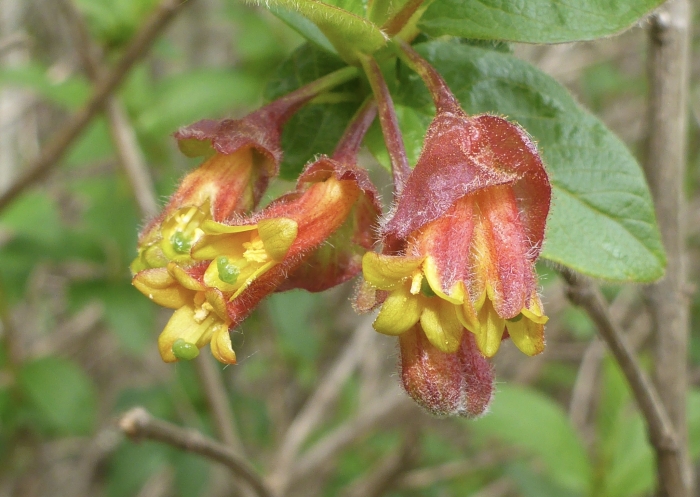Twinberry Honeysuckle
(Lonicera involucrata var. ledebourii)
Twinberry Honeysuckle (Lonicera involucrata var. ledebourii)
/
/

Cricket Raspet
CC BY 4.0
Image By:
Cricket Raspet
Recorded By:
Copyright:
CC BY 4.0
Copyright Notice:
Photo by: Cricket Raspet | License Type: CC BY 4.0 | License URL: http://creativecommons.org/licenses/by/4.0/ | Rights Holder: Cricket Raspet | Publisher: iNaturalist | Date Created: 2021-03-17T21:55:49Z |








































Estimated Native Range
Summary
Lonicera involucrata var. ledebourii, commonly known as Twinberry Honeysuckle, is a deciduous shrub native to the Pacific Northwest, including moist forest clearings, streambanks, and wetlands in California, Oregon, and Washington. It typically grows to a height of 3-9 feet (0.9-2.7 meters) and a width of 3-5 feet (0.9-1.5 meters). This shrub has a bushy form with pairs of oval, dark green leaves and produces striking yellow flowers that are followed by conspicuous black berries encased in red bracts, which are particularly showy in late summer and fall.
Twinberry Honeysuckle is valued for its wildlife-friendly attributes, as it provides nectar for pollinators and berries for birds. It is used in restoration projects, naturalized plantings, and as an ornamental in water-wise gardens. It thrives in moist, well-drained soils and can tolerate a range of light conditions from full sun to part shade. While it is not particularly drought-tolerant, it can adapt to occasional dry spells once established. Gardeners should be aware that it can spread by suckering, potentially becoming a management issue in smaller spaces.CC BY-SA 4.0
Twinberry Honeysuckle is valued for its wildlife-friendly attributes, as it provides nectar for pollinators and berries for birds. It is used in restoration projects, naturalized plantings, and as an ornamental in water-wise gardens. It thrives in moist, well-drained soils and can tolerate a range of light conditions from full sun to part shade. While it is not particularly drought-tolerant, it can adapt to occasional dry spells once established. Gardeners should be aware that it can spread by suckering, potentially becoming a management issue in smaller spaces.CC BY-SA 4.0
Plant Description
- Plant Type: Shrub
- Height: 3-9 feet
- Width: 3-5 feet
- Growth Rate: Moderate
- Flower Color: Yellow
- Flowering Season: Spring, Summer
- Leaf Retention: Deciduous
Growth Requirements
- Sun: Full Sun, Part Shade
- Water: Medium
- Drainage: Fast
Common Uses
Bee Garden, Bird Garden, Butterfly Garden, Deer Resistant, Drought Tolerant, Fragrant, Hummingbird Garden, Low Maintenance
Natural Habitat
Moist forest clearings, streambanks, and wetlands in California, Oregon, and Washington
Other Names
Common Names: Twinberry
Scientific Names: , Lonicera involucrata var. ledebourii, Lonicera involucrata subsp. ledebourii, Lonicera ledebourii, Distegia ledebourii, Caprifolium ledebourii, Xylosteon ledebourii,
GBIF Accepted Name: Lonicera involucrata var. ledebourii (Eschsch.) Jeps.